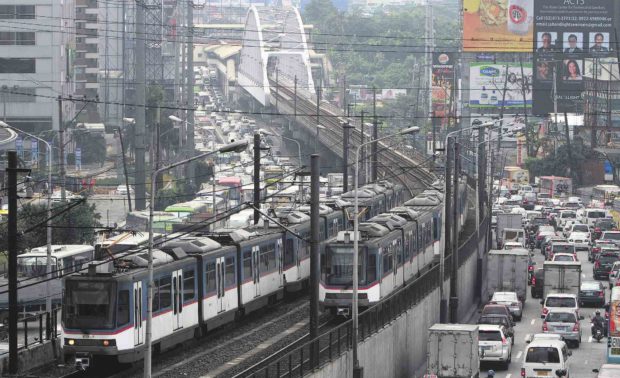
Point-to-point buses will supplement MRT 3 starting on Friday, Nov. 10, 2017. (File photo from Philippine Daily Inquirer)
Starting on Friday, around 30 air-conditioned point-to-point (P2P) buses will be deployed at the Metro Rail Transit-3 (MRT-3) during rush hours to provide commuters an option while the government works on improving the reliability of the country’s busiest train system.
Cesar Chavez, the transport undersecretary for rails, said that at least 20 of the buses would be deployed at the North Avenue Station on Edsa during from 6 a.m. to 9 a.m.
These buses will be escorted by enforcers from either the Land Transportation Office (LTO) or the Highway Patrol Group (HPG) of the Philippine National Police (PNP), and will charge passengers the same fare as that of the MRT-3
Chavez said that southbound buses would only have two stops: the Ortigas Station for P20 and Ayala Avenue for P24.
He added that while the buses would be allowed to have standing passengers, dispatchers from the Land Transportation Franchising and Regulatory Board (LTFRB) would ensure that buses would not be overloaded.
In the afternoon rush, from 5 p.m. to 8 p.m., there will be 20 buses on standby for passengers at the Taft Avenue Station, while 10 buses would be deployed at the Ayala Avenue Station.
Similarly, these escorted buses will drop off passengers only at the North Avenue Station.
Aileen Lizada, LTFRB board member, pointed out that the buses would have escorts to encourage commuters to use them. She noted that, even if with a long queue at the MRT-3, commuters would still opt for the trains than the buses due to the predictability of the travel time.
“Now, we’re presenting an option to the passengers of the MRT-3,” Lizada said.
On average, the stations at Taft and North Avenue each account for around 78,000 passengers daily.
According to Lizada, the buses would not be allowed to pickup passengers along the route and must stay within the yellow lane, which is the two outermost lanes along Edsa.
To ensure faster travel time, Lizada said that enforcers from the Metropolitan Manila Development Authority (MMDA) would also strictly implement the yellow lane’s exclusive use for public utility vehicles.
She pointed out that drivers of private vehicles who would violate this could be fined P500.
Transport officials sought on Wednesday the “voluntary” support of around 40 bus operators to help ferry MRT-3 passengers, especially with only 15 “reliable” trains in service.
On the same day, the MRT-3 broke down at least four times due to failure in the signaling system.
To test the new system, a dry run will be held Thursday by transport officials using four buses of the MMDA.
Lizada said that these buses would offer free rides on Thursday and Friday.
The service might even be extend until after the end of the 31st Association of Southeast Asian Nations (Asean) Summit next week.
According to Lizada, the free bus rides would be on a first-come, first-served basis, while the regular buses would have a tarp bearing the words “Alalay sa MRT-3.”
Chavez noted though that the complimentary bus service would not be in service during the Asean week.
Given that MRT 3 was still procuring the necessary spare parts for the trains and looking for a new maintenance provider, Chavez said that the bus service might run until May next year.
He also advised passengers to arrive in the MRT-3 stations at least 30 minutes earlier than usual to avoid being inconvenienced.
According to Chavez, MRT 3 has around 12 million passengers at the moment, up from just 9.8 million in December last year. /atm

